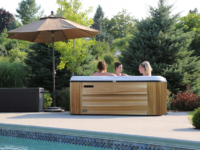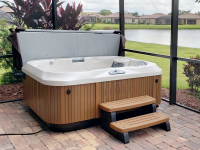Why You Need To Clean Your Hot Tub
Almost everyone cleans their hot tub, but are they cleaning it correctly? If not, they run the risk of not just damaging their hot tub, but also exposing themselves to dangers like skin irritation, infections and, in the most extreme cases, severe pneumonia [4] and even STDs [3].
A hot tub which hasn’t been properly cleaned is a perfect breeding ground for germs. Unless properly disinfected, the warm water, often exposed to sunlight and dust, quickly becomes contaminated. According to the National Institutes of Health/NLM [2], improper cleaning is one of the four top risk factors for developing a disease when using a hot tub, along with not maintaining the correct pH range and not regularly changing the water or filters.
In this guide we break down the principles of properly cleaning and disinfecting a hot tub, based on our interviews with hot tub service technicians, manufacturers and healthcare professionals.
Hot Tub Cleaning Checklist
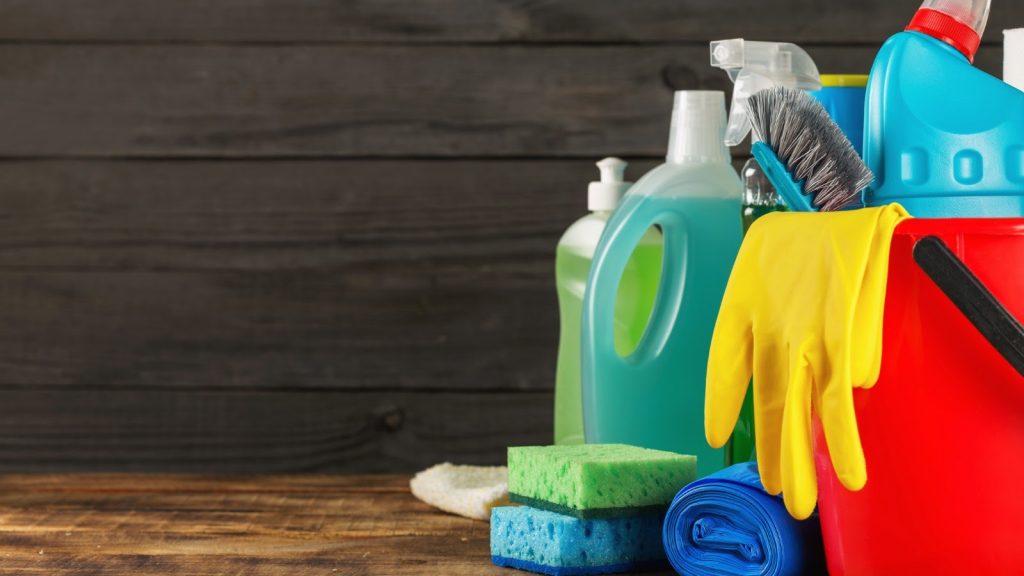
Source: Improve Home
Cleaning your hot tub for more or one person hot tub may seem difficult and time-consuming, but once you follow our all-in-one guide you’ll be amazed how quick and easy it is!
To avoid any health problems, and to make sure your hot tub works better and lasts longer, we recommend setting up — and sticking to! — hot tub cleaning checklist.
My team has conducted extensive research to determine the basic steps how to clean hot tub for you, as a hot tub owner, should perform regularly — regardless of the model of hot tub you own or the type of sanitizer you use.
General steps how to clean hot tub after the each use
Wipe down hot tub with a damp cloth
Carefully wiping your hot tub shell only after each use takes no time at all, but it will keep it cleaner longer and get rid of many minor contaminants.
Check ph level of water and add hot tub sanitizer
Some bacteria and cosmetic contaminants may be found in the water after each use. Sanitizer for hot tub will help eliminate them and keep your hot tub safer and cleaner. At the same time, maintaining the correct pH level of a hot tub helps a hot tub sanitizer to work better.
The most popular types of sanitizers are chlorine and bromine. Chlorine sanitizer kills bacteria effectively, but you need to use it more often than bromine, and it has a strong and distinctive odor. Bromine works more slowly and can be quickly destroyed by UV light. While it is not as good at eliminating bacterias, it still can remove contaminants after the spa procedures. If you want to decrease the use of chemicals, read our guide on chemical-free hot tubs.
Leisure Time Chlor Granules
Price range:$$
• Destroys organic contaminants
• Controls algae growth
AquaChek Test strips
Price range:$
• Shows pH, Total Alkalinity, chlorine and bromine levels
• Helps to ensure clear and safe water
Leisure Time Brom Tablets
Price range:$$
• Easy to use bromine tablets
• Keeps water clean and odor-free
Weekly Hot Tub Maintenance
Check hot tub water
According to John D. Puet, Director of Technology at Advantis Technologies, there are five factors that affect water quality in your hot tub: pH level of water, Total Alkalinity, Calcium Hardness, Stain Producing Minerals, and Total Dissolved Solids (TDS) [5]. These five factors should be checked regularly with special pH test strips.
Shocking hot tub water

Source: Instagram
Shocking a hot tub water is not as shocking as it sounds! It’s nothing more than a large dose of oxidizer, which helps eliminate various contaminants. You should shock hot tub water once a week, especially when you are using the hot tub frequently.
What you need for shocking of hot tub
- Chlorine shock or Non-chlorine shock
- Chemical-resistant measuring cup
- pH test strips
- Chemical-resistant gloves
- Safety goggles
How to shock a hot tub water in six easy steps
- Uncover hot tub. Keep it uncovered up to the end of shocking as shock needs to oxidize.
- Use pH test strips for hot tub water. The recommended pH level is 7.2 – 7.8. If needed, adjust to a normal level.
- Put on pvc gloves and safety goggles, and make sure there is no exposed skin.
- Measure the required amount of shocking product (chlorine or non-chlorine) for your hot tub with a chemical measuring cups.
- Carefully add shocking product (chlorine or non-chlorine) in the water.
- Circulate hot tub water for at least 30 minutes.
SpaGuard chlorine Shock Treatment
Price range:$
• Highly effective in killing germs and eliminating wastes
• Has a foul odor
(Read details)
Spa Essentials Non-Chlorine Shock Treatment
Price range:$$
• Less effective in eliminating wastes
• Doesn’t produce a chlorine-like odor
(Read details)
How shock of hot tub works
Shocking a hot tub is an important part of keeping the hot tub clean and getting rid of different types of contamination. Shocking a hot tub is just a large dose of oxidizer. This hot tub cleaning procedure accomplishes three main goals:
- Killing bacteria, which appear in hot tub water as a result of continuous hot tub usage — bathers leave contaminants from their bodies and the products they use.
- Allow clean products to work more effectively.
- Removing chloramines in water or bromamines (depending on your type of sanitizer).
If you skip shocking a hot tub, it can result in biofilm formation, changed water color, white gunk formation on the water, and foul odor. These are all difficult to eliminate, so it’s better to prevent them.
Non chlorine shock vs chlorine shock
There are two types of products shocking a hot tub water. Each has its pros and cons, and so should be used according to the requirements of the specific case.
Note that you can use a shocking product despite your type of sanitizing system.
| Chlorine shock | Non-Chlorine shock |
| Highly effective in dealing with bacteria and organic compounds | Less effective in killing bacteria |
| One of the cheapest types of sanitizer | More expensive type of sanitizer |
| Produces foul odor | Doesn’t have a chlorine-like odor |
| Evaporate with time due to impact of UV-rays | More stable at high temperatures and lasts longer than chlorine |
How to clean hot tub filter
Rinse a hot tub filter is a pretty easy way to maintain your hot tub filter’s cleanliness on a weekly basis. This procedure will prolong the life of your hot tub filter and keep clean your hot tub a safe place. All you need is a garden hose that is safe for hot tub and water.
- Remove hot tub filter. It must be located at the side of the hot tub, under a filter lid or inside the filter canister. Don’t forget to turn off the power of your hot tub before removing the filter.
- Clean hot tub water by warm water.
- Allow your filter to dry before placing it back into your spa.
- Put back hot tub filter.
Monthly hot tub cleaning
Use hot tub filter cleaner spray
Even with regular rinsing, germs and other contaminants will still accumulate in the filter, so it is important to use hot tub filter cleaner spray on a monthly basis. This will help prevent the contaminants from getting into the water.
- Remove filter. As a rule, it is located at the side of the tub, under a filter lid or inside the filter canister. When you found the filter, cut the power to your hot tub by switching off the circuit breaker and then remove the filter.
- Use hot tub filter cleaner spray.
- Rinse with water to avoid cloudy hot tub water.
- Dry hot tub filter before you put it back in.
- Put back hot tub filter.
Leisure Time Instant Cartridge Cleaner
Price range: $
• Removes oil, grease from the filter
• Works with all types of sanitizing systems
How to clean hot tub cover
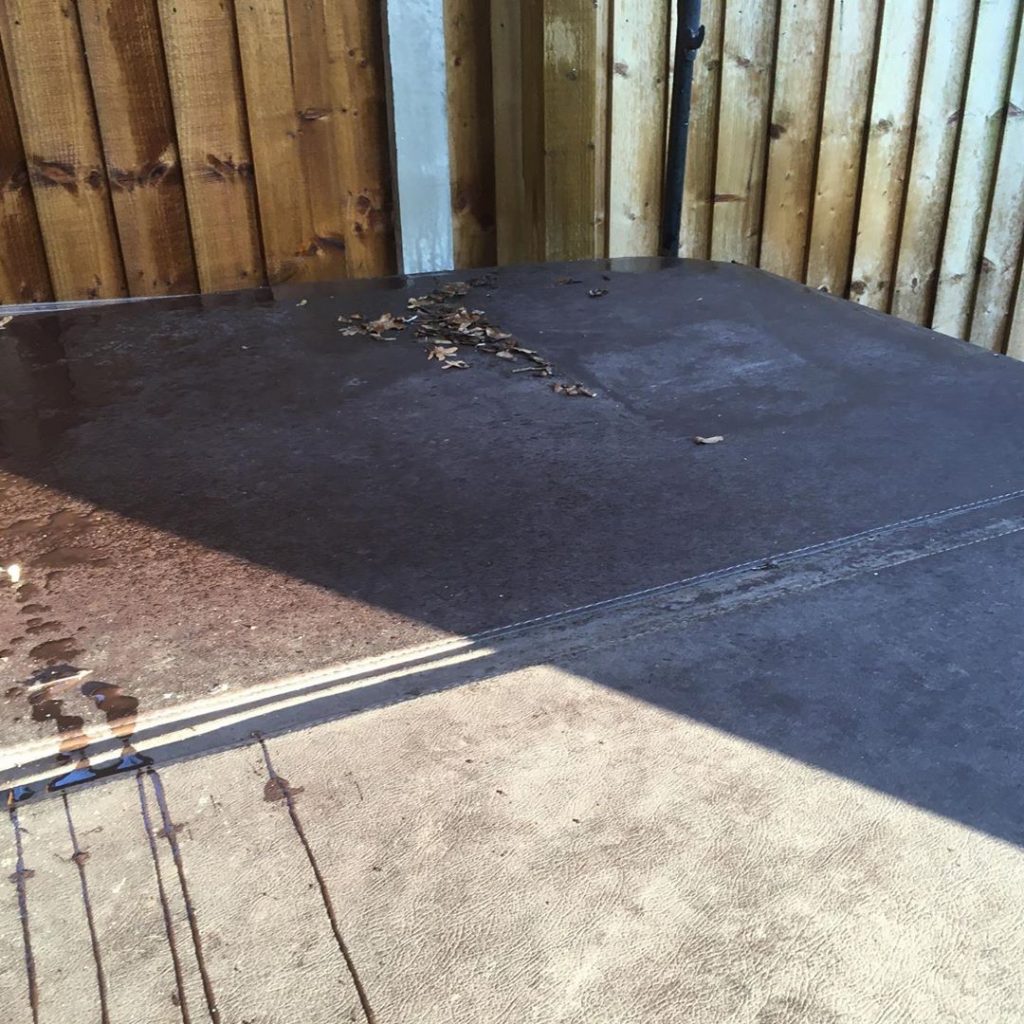
Source: Instagram
It is important to clean hot tub cover to avoid dirt build-up on it. Unless this is done, the bacteria from the hot tub cover will get into the hot tub water. So the hot tub cover will not be able to perform its primary function — protect water from outside contaminants.
If you do not use the hot tub cover, bacteria will grow on the underside, causing mold and mildew growth which can cause foul odors.
What you need for cleaning hot tub cover
How to clean a hot tub cover in 8 steps
- Remove your hot tub the cover to prevent getting dirt and cleaning products inside the hot tub.
- Wash off dirt and leaves from the hot tub surface with a hose.
- Apply hot tub cover cleaner on the surface.
- To allow penetration let it sit for 15-20 minutes.
- Clean it with a microfiber cleaning cloth.
- Rinse hot tub cover with water.
- Using a dry rag, wipe it off.
- Flip the cover over and repeat steps 1 to 7 on the bottom.
Leisure Time Cover Care and Conditioner
Price: $
• Works with all sanitizers
• Protects from UV rays
• Repels water and dirt
Quarterly hot tub cleaning
Clean hot tub pipes

Source: Instagram
The hot tub pipes are a concealed part of your hot tub. The purity of the water that comes into your hot tub depends on the cleanliness of the pipes.
Hot tub pipes pollution can lead to problems with water, which may turn red-yellow or cause a foul odor.
Bacteria are in the water in your hot tub, and the hot tub can become an ideal environment for germs such as Legionella and Pseudomonas to grow. These germs can cause Legionnaires’ Disease, serious infections such as skin rashes, eye, and ear infections, or pneumonia.
You should clean the pipes before draining hot tub water.
What you need for cleaning hot tub pipes
How to clean hot tub plumbing
- Remove filter
- If needed, adjust the water level, but do not drain it
- Measure the required amount of flush line product relative to your hot tub’s volume
- Add a hot tub flush line product into the spa water
- Open diverter valves (if your hot tub model has this feature)
- Run hot tub jets on high speed for 30 minutes or leave to circulate overnight at low speed
Note: Your hot tub will foam, which is okay. Flushing hot tub lines removes a large amount of germs, biofilms, and organics.
SeaKlear Spa System Flush
Price range: $
• Superformula to clean plumbing system
• Can be used on all hot tubs
• No harsh chemicals
Drain hot tub
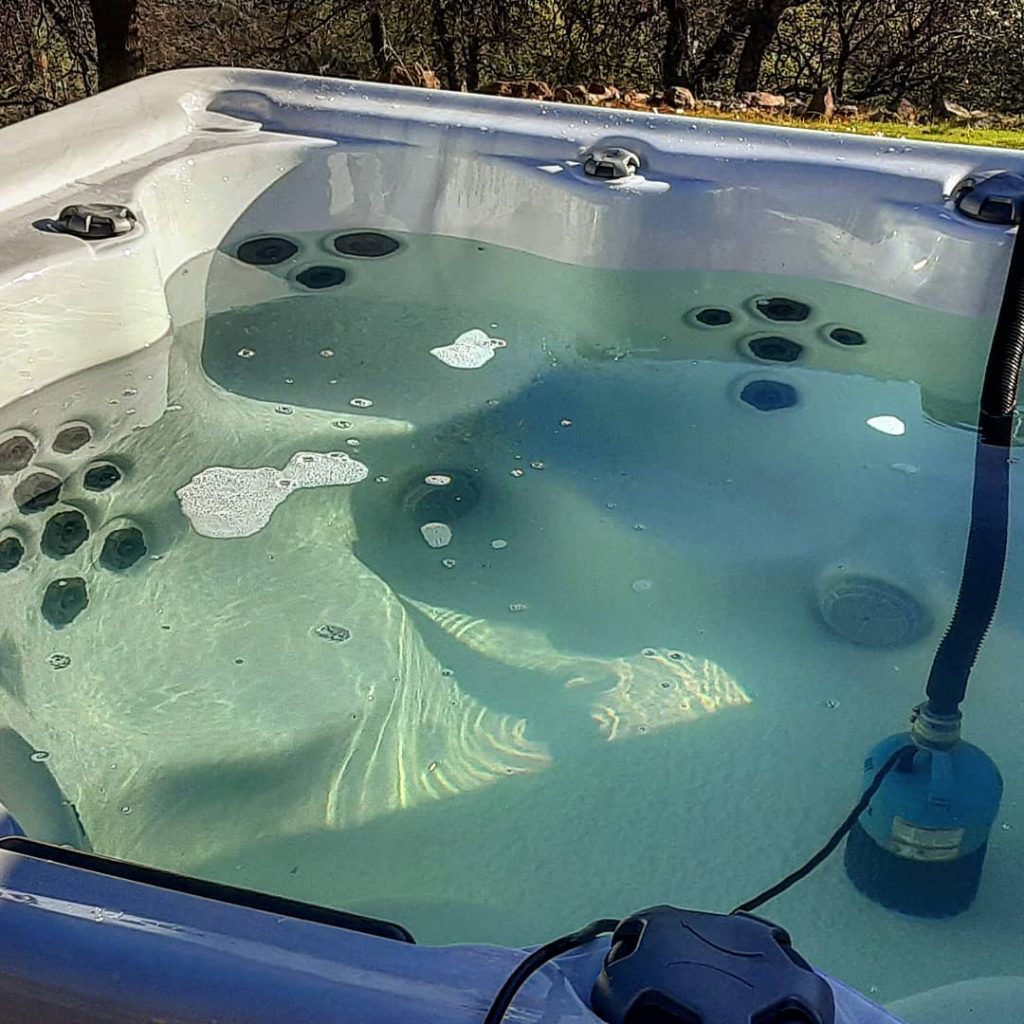
Source: Instagram
Draining a hot tub is a must-do. The recommended frequency is once every three or four months. But everything depends on the water quality and how often you use your hot tub.
When you do not change the water in the hot tub for a long time, it gets dirty and gunk may appear on the surface. It also becomes more difficult to balance the water, which gets hazy and makes the shell gritty.
Below we will provide you with two draining a hot tub methods and step by step guide on how to clean hot tub water. If you clean the hot tub to winterize, read the section with hot tub winterization in our article.
Tools for cleaning hot tub
Hosepipe, Submersible Sump Pump — if you want to drain hot tub water extremely quickly.
Garden hose
Price range:$
• Slower way to drain water
• Leak-free and durable
Sump pump
Price range:$$
• The quickest way to drain water
• Drains water even from the hard-to-reach places
Where to drain hot tub water?
You can drain hot tub water out on the lawn, garden, and sewer systems. But, before pouring hot tub water on grass and plants, make sure the water is balanced using test strips. The pH level should be 7.2 – 7.8 and Total Alkalinity in the range of 80-150 ppm.
If the water is not pH balanced, grass can turn yellow and plants may suffer.
If your hot tub requires additional treatment because the water is at an extreme level of chlorine or bromine, you can run a garden hose in the sink at your house.
NEVER drain hot tub water in the storm drain, because his water will flow into natural bodies of water and will damage the aquatic ecosystem.
How to drain a hot tub with a hose
This is the cheapest way to clean your hot tub. A garden hose is a good choice for owners of small hot tubs or for anyone who has enough time and need not hurry with cleaning hot tub.
Do not try to speed up the cleaning process by using a hot tub pump. This means running the spa pump without any water, which can damage the pump.
The disadvantage of the hose method is that the water won’t clean completely. Some hard-to-reach places, like seats and footwell, will retain water.
Here are the six steps how to drain the hot tub with a hose:
- Turn off the circuit breaker that connects to the hot tub.
- Find a drain plug. Usually, it is located at the bottom of your hot tub, but it also can be in the corner.
- Attach the hose. Make sure the hose is empty. If your hot tub model does not have its own attached hose, use the garden hose.
- Some hot tub models have two plugs — primary and auxiliary. First, open the primary plug to drain most of the water. Then open the auxiliary valve to remove water from plumbing.
- Run the hose downhill or on level ground to the place where you are draining the water.
- Open the ball valve on the spigot and let the water drain.
How to drain using hot tub pump-sump
Hot tub pump-sump is the quickest way to drain your hot tub and takes approximately 10 minutes for medium-large hot tubs. This pump will drain all the water from your hot tub. It is a more expensive method then draining hot tub with a garden hose. Keep in mind that you must monitor the pump-sump while it drains water because, if the pump continues to run when there is no water in the hot tub, it can burn up the motor.
Pump-sump will be the perfect choice for owners of big hot tubs and for entrepreneurs who have a business connected with spas and hot tubs.
- Turn the power off at the circuit breaker.
- Connect a garden hose to the sump pump.
- Place the pump inside the hot tub at the deepest point.
- Run hose’s open end to the drain place.
- Turn the pump on and let the water drain.
- Once a hot tub is empty, turn off the pump.
- Remove the pump from the hot tub and detach the hose.
Clean hot tub filters
Your hot tub filter periodically needs a more extensive cleaning to thoroughly remove all bacteria and other contaminants. Soaking your filter with a filter deep cleaner four times a year allows it to work at maximum efficiency, ensuring clean and crystal clear water.
This is a necessary procedure when you drain hot tub water. It provides deep cleaning and gets rid of contaminants.
- Remove filter.
- Fill a 5-gallon bucket with water.
- Add filter soak product according to instruction.
- Let it soak for at least 1 hour in hot water or overnight in the cold water.
- Thoroughly rinse the filter with water.
- Let it air-dry.
- Insert filter.
SpaDepot Filter Cleaner
Price range: $
Deep filter cleaning
Works with all sanitizers
Removes organic contaminants (cosmetics residues, dirt)
Economical to use
Clean hot tub shell
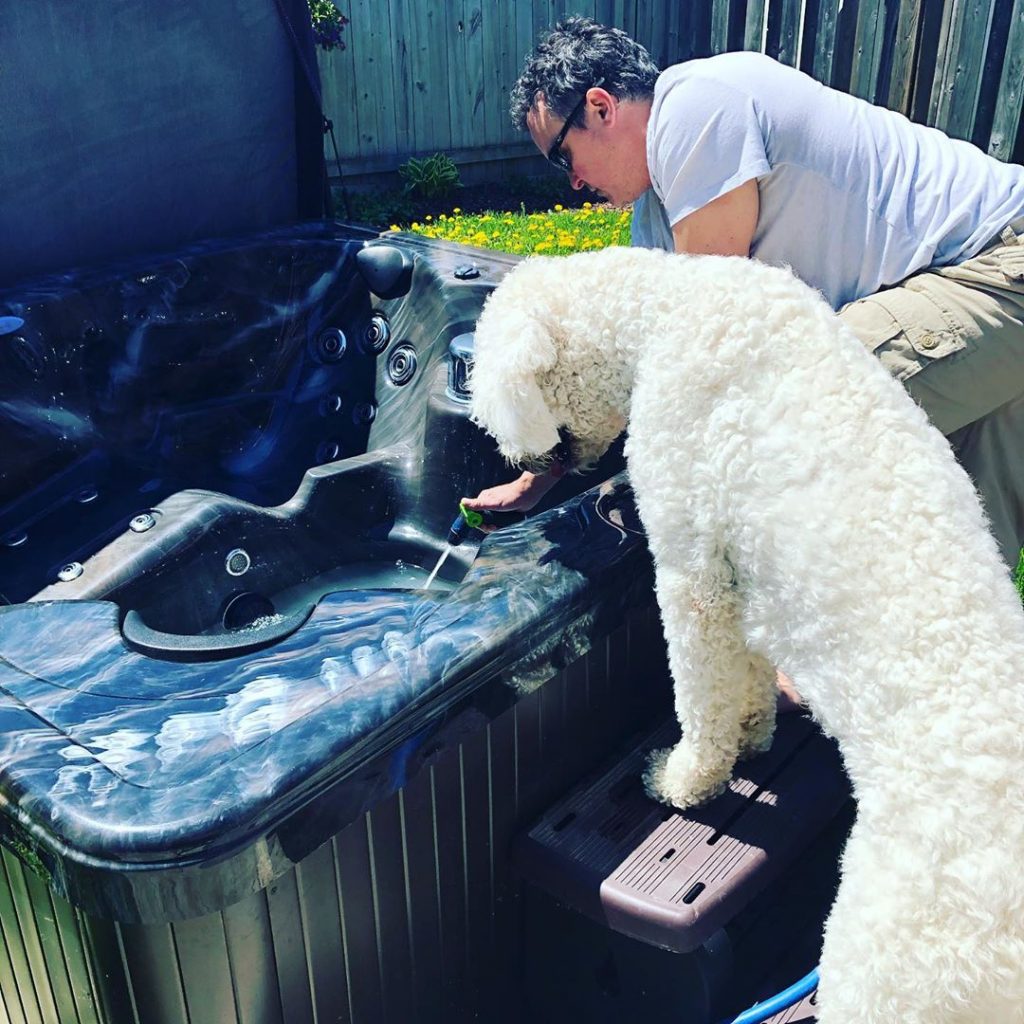
Source: Instagram
Every time you bathe in it, you come into contact with your hot tub’s surfaces. Dirt may build up in hard to reach places such as the footwell and jets. The hot tub shell’s moist environment is favorable for bacterial growth, so it needs care. You are not always able to see this dirt but, when a hot tub is drained, you may be in for an unpleasant surprise.
For regular care of your hot tub, all you need is a light cleaning spray and a cloth.
But once you notice strong buildups, you should use “heavy artillery” to scrub away the dirt.
What you need know about shell cleaning
| For light cleaning | For hard cleanup |
| Hot tub cleaner spray | Hot tub cleaner |
| Non-abrasive cloth | Non-scratch nylon scrubber |
| Hosepipe | Hosepipe |
How to clean a hot tub shell
For planned light cleaning hot tub shell you should follow 3 easy steps:
- Spray hot tub shell with hot tub cleaner spray.
- Gently clean it with a non-abrasive cloth to avoid scrubber.
- Rinse with water to avoid foaming.
If your hot tub shell requires extra cleaning, then:
- Apply hot tub cleaner on its surface.
- To get rid of hard dirt, use a non-scratch scrubber.
- Let it dry for 10-15 minutes.
- Rinse the hot tub shell with water.
Refilling hot tub
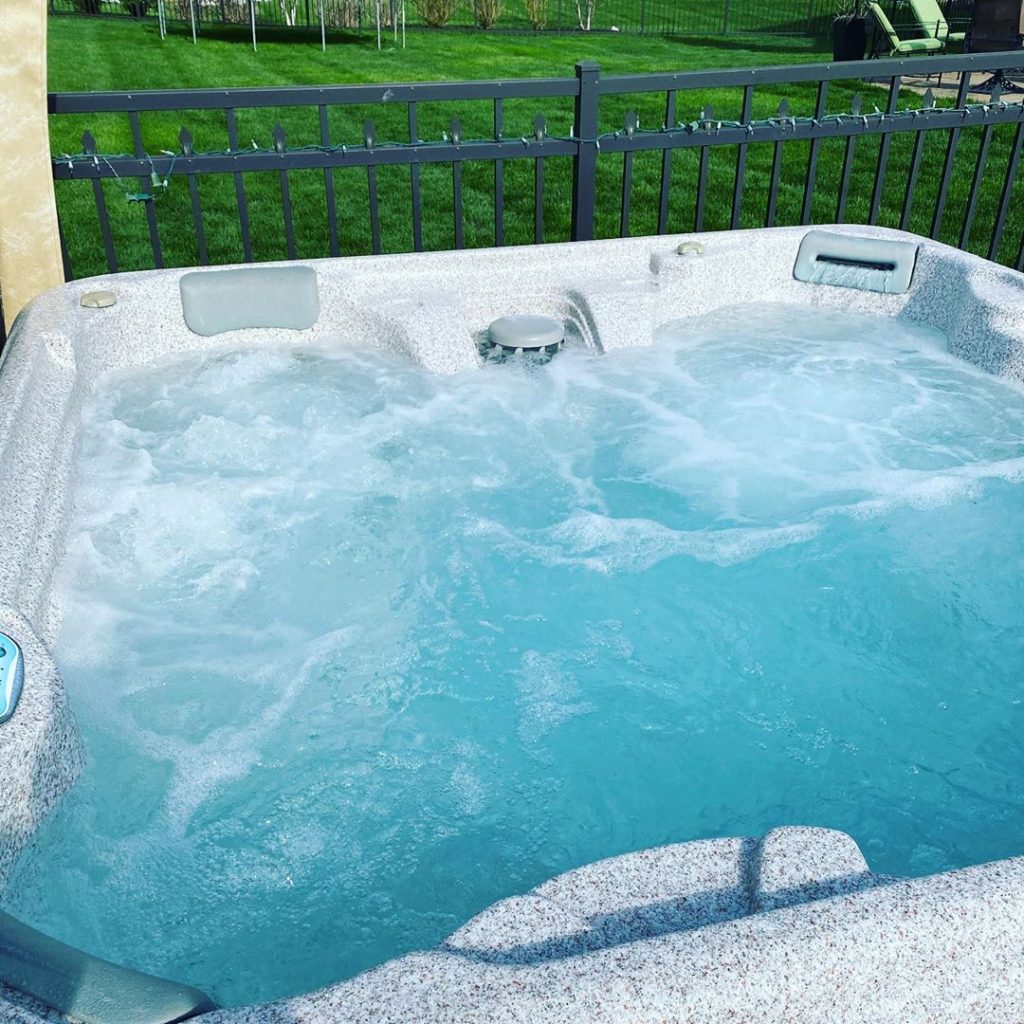
Source: Instagram
Refilling hot tub is a pretty easy procedure to do before enjoying time in your hot tub, but there are still some tricky issues you should keep in mind.
How to refill a hot tub in 10 steps
1. Make sure a breaker is still off.
2. Check jets (must be open).
3. Stick the end of the hose into the filter compartment.
4. Turn on the spigot. At this stage, you can use pre-filter to fill the hot tub with the purest water.
5. Once the hot tub is filled with water, detach the hose.
6. Turn the spa breaker on.
7. Add sanitizer and chemicals (chlorine or bromine) in the water.
8. Test water and adjust if needed.
9. Let chemicals circulate for 12 hours.
10. Retest the water.
Yearly hot tub cleaning
Replace hot tub filter
Your little hot tub filter has worked hard for you over the last year so that you can relax and enjoy safe, clean and clear hot tub water, but now it’s time for a brand new filter.
| Filter type | Description |
| Cartridge filter | The most popular type. These filters are made of fabric, plastic. |
| Sand filter | It looks like a container filled with sand and is located outside of the hot tub. This sand pulls out dirt. This type of filter needs more frequent cleaning than any other. |
| Ceramic filter | This type of filter is made with a resilient ceramic. If you clean the filter regularly, it can last up to several years. |
| Diatomaceous Earth Filter | More earth-friendly type of filter. It is made of crushed petrified bones and lasts for two to three years. It is the most expensive type of filter. |
Examine hot tub’s hardware and wiring
Some parts of your hot tub may be damaged or broken for various reasons, such as improper maintenance or simply normal wear and tear. So, every year, you should thoroughly examine all of the spa’s hardware and wiring, replacing and repairing where necessary, to avoid any problems in the future.

Proven Signs Your Hot tub Needs to be Cleaned
There are warning signs you should look out for that will tell you whether your hot tub needs to be cleaned before the set schedule. These indicators can be seen, smelled, and even felt. Below we describe a “canary in the coal mine” test for cleaning a hot tub, as well as how to deal with these problems.
Different hot tub water color
Green hot tub water
There are several reasons why hot tub water turns green:
1. Excessive mineral content such as copper or manganese. This is the most common cause, especially if you use well water to fill your hot tub. Copper can also enter from the hot tub pipes that carry water to your hot tub.
When the cause is mineral in nature, the water will be slightly green and will not feel slimy.
To get rid of this problem you should do a shock hot tub with a chlorine shocking product and soak the filter in the filter deep cleaner. If this does not fix the problem , the issue may be with the pipes, which should be cleaned and the water then drained.
2. Algae. While not as common a cause as minerals, algae can still cause water to turn green, especially if you do not use a hot tub cover. If algae is the problem, the water will feel slimy.
In this case, shock hot tub with a chlorine shocking product and replace the filter with a new one.
Yellow hot tub water
Yellow watercolor is another common hot tub problem. Why does the water turn this color? What can you do about it?
1. People with a bromine spa system frequently encounter this issue. The cause lies in the high bromine residual and low pH. If having tested the bromine and pH level, you decide that’s the case, then you should use chlorine neutralizer. You won’t need a lot, once you follow the instructions. To mix the product with water, turn on the pump and/or aerator for at least 30 minutes. Afterward, check the bromine and pH levels, which should now be lower than your previous measures.
2. If the levels are the same, however, an alternative cause could be iron oxide. How can you be sure? If the spa turns yellow or yellow-red after shocking, and if over time the water becomes brown, iron oxide is the most likely culprit. To fix the problem, shock water, thoroughly clean the pipes, soak the filter in chemicals, drain the water, and then refill. If you use a well water system, you should minimize the minerals in the water, so we recommend using a pre-filter. After refilling the hot tub, rinse the filter with water two to three times a day for the next few days.
3. Yellow algae. In this case, bromine and chlorine levels will be normal. To remove yellow algae in hot tub water, first balance the water, then turn off the heater, and lastly shock water with a high level of chlorine shock. Afterward, remove the hot tub cover and let air circulate for several hours. When the chlorine level drops to zero, do a shock hot tub water once again. Now you can clean the pipes, drain the water, scrub the hot tub shell, and clean cover. Don’t forget to replace the filter.
4. There is another very simple reason why the water can have a yellow color. If you have dumb friends, it’s also the most likely one. It’s the same thing that causes yellow snow. In this case, you will need to shock (yes, shock it again, but this time with chemicals) and drain the water. You may also want to get new friends.
Brown hot tub water
As with yellow water, high levels of iron oxide can also make the water turn brown. The most effective method is removing and cleaning the filter with cleaner.
To avoid getting minerals in hot tub water, we recommend using pre-filter.
White hot tub water
White water can be caused by insufficient rinsing with water after cleaning the filter.
Check the alkalinity, since white water often indicates high levels (over 80-150 ppm). However, if the alkalinity level is good, white water might come from the ineffective filtering of contaminants such as body lotion or cosmetics, which can create a biofilm. In this case, do a Shock hot tub with chlorine shocking product, raising the chlorine level to 30 ppm. Then run hot tub water for several hours and drain. Replace the filter with a new one. After this, soak all removable items in a strong bleach solution (mix bleach and water in the bucket). Do not forget to clean the pipes.
Foul hot tub smell
An offensive hot tub smell may be caused by frequent usage of a hot tub or lack of use over a long period. Odors can also be caused by inadequate ventilation in the spa room (if your hot tub is indoors). To prevent offensive odors, you should shock water, clean pipes, filter, drain and scrub shell, hot tub cover.
Hot tub foaming
Foam in a hot tub may appear because of insoluble compounds such as sweat and cosmetics. Cleaning products can also cause foam, especially household cleaners or products that contain soap. Avoid using such products to clean your hot tub.
You should also rinse the spa parts with water after applying the chemicals since residue can also cause foaming to occur.
To get rid of foaming, just do a shock hot tub water and drain.
Scale in hot tub
Scale is caused by many people using the hot tub on a frequent basis. You can stop scale from forming through frequent shock hot tub water treatments. But once the scale appears, drain water partially and use a light product for cleaning the hot tub shell. If that does not help, use a cleaning product for the worst affected surfaces.
Frequent hot baths
Is it a high season and you spend every evening in your hot tub? Or you had guests this week? It means you should pay more attention to the cleanness of your hot tub. It definitely needs to be shocked more frequently. Drain water and clean hot tub parts (filter, hot tub shell, cover) if you notice problems with the water and surface areas.
Not frequent using hot tub baths for a long time
Has your hot tub sat unused for a long time? If so, you should drain, remove and clean filters, blow out pipes, clean hot tub shell and cover. After refilling you can use your hot tub safely once again.
Tips to Keep Your Hot Tub Clean & Safe
Before you start with the cleaning and draining routine, you should note these safety rules. Better be safe than sorry.
1. Before draining water, make sure power to your hot tub is turned off.
It is a dangerous combination — water and electricity. Disconnect any electrical cords before draining. Besides safety reasons, having the hot tub connected to a power supply can damage the pump motor and filter mechanism, if the pump is turned on when there is no water.
2. Make sure you cover all exposed skin areas and put on safety goggles, chemical-resistant gloves when you clean a hot tub with chemicals.
This safety tip applies especially to the process of shocking water, since this involves a large amount of chemicals. Chemicals which are strong enough to remove old dirt and scrum can easily damage your skin and cause eye irritation, while chemical vapor is bad for your respiratory system.
3. Use cleaning products and chemicals made for hot tubs.
A typical mistake is to use cleaning products which are intended for house use (e.g. bleach, dish soap) or for pools only. A lot of brands design cleaning products for both pools and hot tubs, and this will be indicated on the package. So, before buying a product, check whether it can be used for hot tubs. Inappropriate cleaning products and chemicals can lead to health problems (rashes, allergy, throat, and eye irritation) and also damage your hot tub.
4. Follow manufacturer guidelines for your hot tub and instructions for cleaning products, chemicals you use.
In the guidelines from the hot tub manufacturer, you will find information about the volume of your spa. This will determine the proper ratio of chemicals and cleaning products. To use the right amount, follow the instructions precisely. If products are too concentrated in your hot tub, this can cause rashes and allergic reactions. If the products are not concentrated enough, your hot tub will not be properly sanitised, which can lead to other health problems.
5. Do not mix different types of chemicals or cleaning solutions.
Mixing completely different product types leads to unexpected combinations, which may affect both your health and your hot tub.
6. Thoroughly rinse off chemicals from pipes, filter, shell, and cover.
Filter and pipes should be clean at all times as water pours through them into the hot tub. The outside of the pipes should be free of any chemicals, since even traces can reduce the hot tub’s water quality and cause problems like rashes.
Typical hot tub cleaning mistakes
Using vinegar instead of a flush line product when clean pipes
Vinegar will not tackle bacterias and build-ups in the pipes. You will not be able to check whether a hot tub plumbing system is clear after using a concentrated vinegar solution. So we recommend using a product made for this purpose.
Not rinsing the parts with water properly
Once you’ve sprayed the filter with a cleaning product or soaked it in the filter deep cleaner, you should rinse it with clear water to avoid foamy water after refilling the hot tub.
Using a brush on the filter
If you notice dirt on the filter, do not use the brush to get rid of it, as this can entrench the dirt. Instead, try stronger water pressure or chemicals.
Not using a pre-filter
If you live in an area with hard water (water that contains a big amount of minerals), you should use pre-filter while refilling the hot tub. The main filter is not going to deal with minerals properly. Pre-filter will prevent minerals from coming into your hot tub.
Not paying attention to details
Small lines and the jets may be overlooked while shell cleaning. But such tricky places can be the germs epicenter. Over time, this will harm your health and damage your hot tub.
Miss cleaning the acrylic shell
Although acrylic shells are resistant to germ aggregation, this does not mean that you can miss planned cleaning. The only difference is that you can clean the shell with light or mid-strength cleaners.
How to Keep Hot Tub Crystal Clear
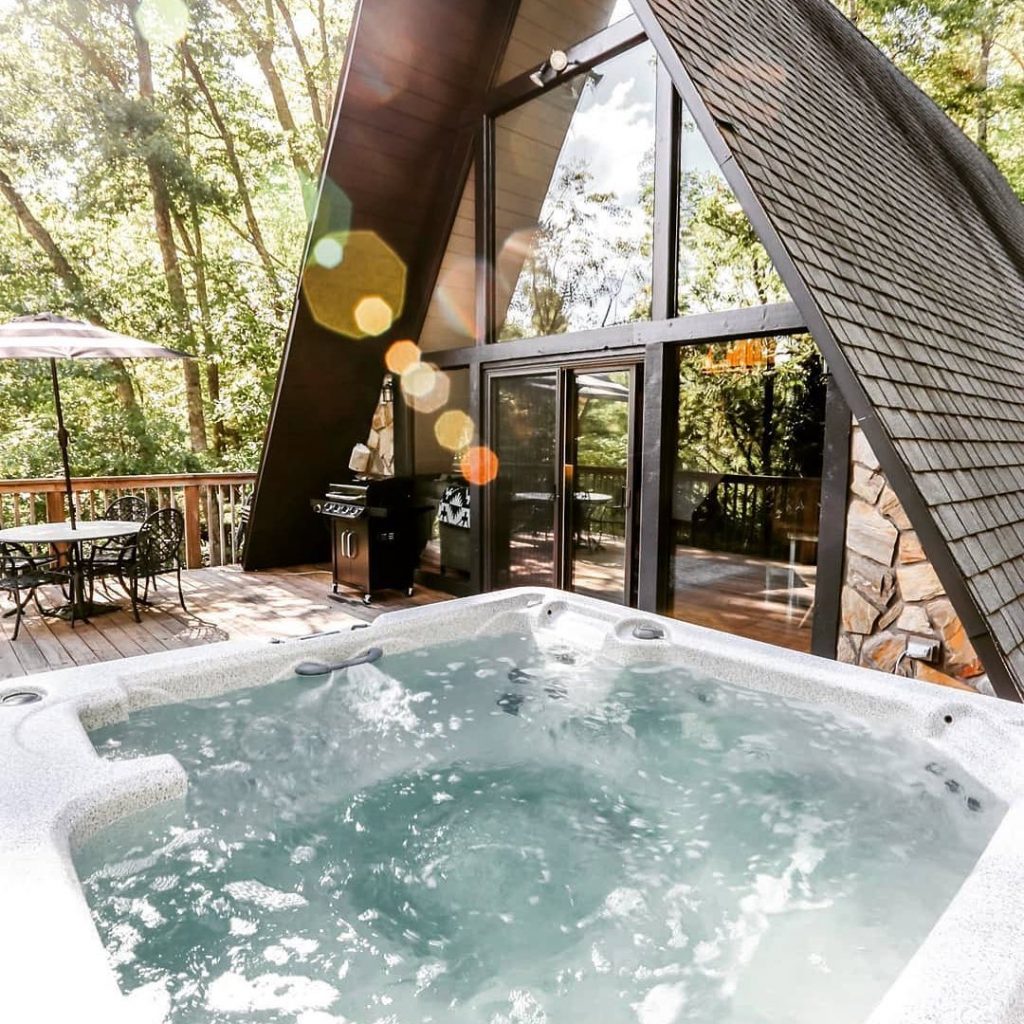
Source: Instagram
Cover hot tub when not in use
The hot tub cover is designed to protect your hot tub water from contaminants from the environment. Do not forget to cover the hot tub when you do not use it. It will not let leaves, dirt, tree sap to get into hot tub water. This is especially important in springtime when there is pollen everywhere.
Take a shower before hot tub bathing
During the day you use body lotions, cosmetics, body oils, and the particles will get into hot tub water. Dead skin cells can also get into the water. A quick shower and light scrubbing before your hot tub soak will keep your hot tub water free from bacteria.
Do not go in a hot tub if you feel sick
If you have diarrhea, or you’ve been vomiting, or you have some cuts or skin abrasions, refrain from using your hot tub until you have been symptom-free for 48 hours. High temperatures can worsen your condition and microorganisms from your body will contaminate the water.
Summary
Cleaning a hot tub may seem challenging: it requires knowledge of hot tub parts, it needs attention, sticking to rules, and discipline. But it is worth it.
Cleaning is extremely important, as a dirty hot tub can cause health problems and damage your hot tub. If you want to avoid such problems, stick to a cleaning routine, and have happy bathing!
FAQ
🧴Will vinegar clean my hot tub?
❌Can I clean the hot tub without chemicals?
You can use vinegar or baking soda for cleaning up minor dirt. However, you need to add chemicals to get rid of bacteria. You can use sanitizers (chlorine or bromine) and a spa shock product (chlorine or non-chlorine).
⏲ How often should I clean the hot tub?
🧐 Should I clean the hot tub if it was untouched for months?
Yes! You should clean the tub before you use it again. Flush the lines, soak the filter in chemicals, clean the hot tub’s shell, and now you can refill with water.
References
1. Facts about hot tub rashes. — U.S. Department of Health and Human Services. Centers for Disease Control and Prevention: https://www.cdc.gov/healthywater/pdf/swimming/resources/pseudomonas-factsheet_hot_tub_rash.pdf
2. Investigation of Spa Pools Associated with Lung Disorders Caused by Mycobacterium avium Complex in Immunocompetent Adults: https://www.ncbi.nlm.nih.gov/pmc/articles/PMC492441/
3. Kandamuthan S., Thambi R., Yeshodharan J. Trichomoniasis: Is it always sexually transmitted? — US National Library of Medicine National Institutes of Health: https://www.ncbi.nlm.nih.gov/pmc/articles/PMC4553853/
4. Outbreaks Associated with Treated Recreational Water — United States, 2000–2014: https://www.ncbi.nlm.nih.gov/pmc/articles/PMC6048947/
5. Puetz, J. D. Understanding Hot Water Chemistry. Retrieved from: https://www.apsp.org/Portals/0/PDFs/Advantis%20Spa%20Chemistry%20Book%20-%20ENGLISH.pdf
6. Residential Hot Tubs and Pools: Safe Water Quality (February, 2018) — HealthLink BC: https://www.healthlinkbc.ca/sites/hlbcprox-prod.health.gov.bc.ca/files/documents/healthfiles/hfile27b.pdf
7. Spa Water Trouble. Retrieved from: https://vaughanpools.com/pdf-files/Spa%20Water%20trouble.pdf
8. Using the wrong hot tub chemicals can damage your hot tub! — The comfort zone: mobility aids & spas: https://albernicomfortzone.com/article/using-wrong-hot-tub-chemicals-can-damage-your-hot-tub
9. Your Disinfection Team: Chlorine & pH Protection Against Recreational Water Illnesses (RWIs): fact sheet for pool staff/owners. — Healthy Swimming: https://www.cdc.gov/healthywater/pdf/swimming/resources/disinfection-team-chlorine-ph-factsheet.pdf


